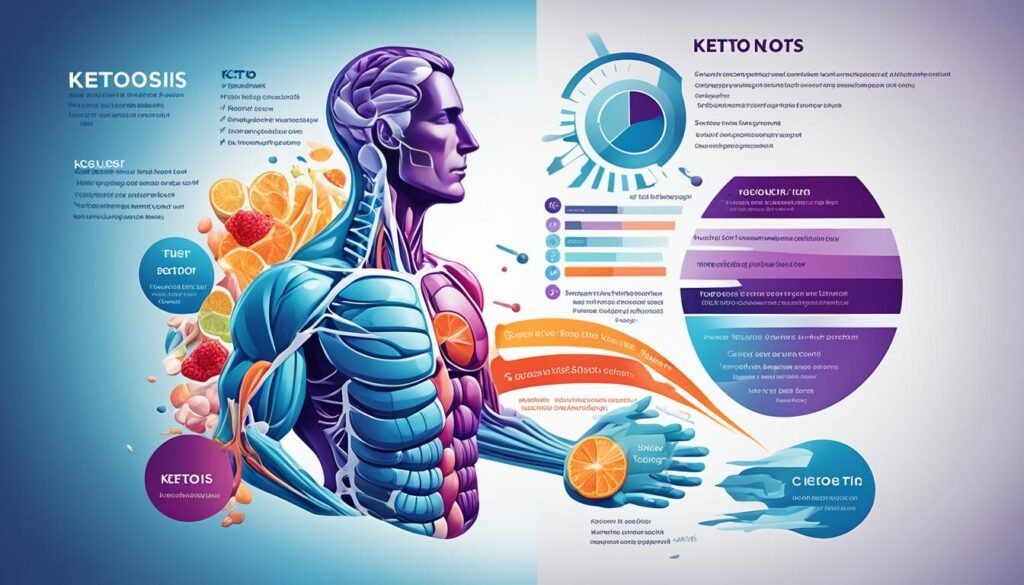When your body enters ketosis, it starts burning fat instead of carbs for energy. This change happens in diets that are low in carbs, like ketogenic diets. It helps you lose weight and affects your hunger and energy. Knowing the signs of ketosis is key to make sure the diet works. It also helps you avoid ketoacidosis, a serious health issue.
Certain signs show you’re in ketosis, such as a special breath smell, changes in weight, and how hungry you feel. At first, you might lose water weight. After that, losing fat shows the diet is working well. High levels of ketones, like acetone, become your main energy source. This changes your health. If your breath smells bad, it means you have a lot of ketones. Drinking water and taking care of your teeth can help with this.
To be sure you’re in ketosis, you can check the ketone levels in your blood. Not everyone thinks the keto diet is a good choice. But, if you follow it right, it can be safe and effective. Knowing how to deal with the side effects of the keto diet can help you reach your health goals easier.
Understanding Ketosis: What Is It?
Ketosis is where your body uses fat instead of glucose for energy. This happens when you eat fewer carbs. The liver then creates ketones, like beta-hydroxybutyrate (BHB), turning fat into energy. This process is key to the ketogenic diet.

Definition and Process
Ketosis starts by cutting down on carbs, leading the body to burn fat. This leads to lower insulin levels and more fat breakdown. You may notice less hunger and steady weight loss. It’s important to know ketosis is different from ketoacidosis, which can be dangerous for diabetics.
Ketones as a Fuel Source
When in ketosis, ketones provide energy. Beta-hydroxybutyrate (BHB) is a main ketone body. It’s vital for energy during fasting or following a strict low-carb diet. You might see changes in breath smell or feel more energetic.
To make sure you’re in ketosis, you can measure ketone levels in your blood or breath. It shows if you’re following the ketogenic diet correctly. If you feel a drop in energy then gain mental clarity, it might mean you’re entering ketosis. Watching these signs helps stick to the diet and keep ketosis going.
What Are the Common Ketosis Symptoms?
Entering a ketogenic state is a big change, especially if it’s new to you. One major side effect is known as “keto flu.” It brings temporary tiredness and a sudden energy drop.
Bad breath is another common sign. It happens because your body gets rid of extra ketones like acetone. Good oral hygiene and drinking plenty of water can help manage it. You might also notice less hunger. This is because of changes in your hormones that decrease your appetite.

When your body starts adjusting, you’ll likely lose some water weight at first. Then, you’ll begin losing fat more steadily. Many people also report better focus and varying energy levels. Your muscles might feel weaker and less enduring for a bit, but this will improve.
Variations in how you digest food and sleep patterns are also typical. While these side effects might bother you at first, they usually get better. This happens as your body adapts to burning fat for energy.
Physical Indicators of Ketosis
Understanding the physical indicators of ketosis can tell you if your body is adapting to a low-carb diet. Spotting these signs confirms your entry into a fat-burning state. Achieving this state is key for your diet goals.
Bad Breath and Dry Mouth
Bad breath is a common sign of ketosis, smelling fruity or metallic. It happens because your body is getting rid of acetone through your breath. To lessen this, focus on oral hygiene and drink lots of water. Dry mouth also happens often on this diet, making you thirsty.
Short-Term Fatigue
As you start using ketones and fatty acids for energy, you might feel tired. This tiredness is normal while your body adjusts to its new energy source. Soon, you’ll likely see your energy go up as you adjust to burning fat.
Weight Loss
Weight loss is a big sign you’re in a fat-burning state. At first, it’s mostly water weight you lose. Stick with the keto diet, and you’ll start losing body fat. Keeping an eye on weight changes helps track your ketosis journey.
Muscle Cramps and Spasms
It’s common to have muscle cramps and spasms when you first enter ketosis. This happens as your body loses more minerals like sodium and magnesium. Taking extra minerals can reduce cramps and help your muscles as you get used to your low-carb diet.
| Keto Symptom | Description | Mitigation |
|---|---|---|
| Bad Breath | Fruity or metallic scent in breath due to expelling acetone. | Increase oral hygiene; drink more water. |
| Dry Mouth | Increased thirst and dry sensation in the mouth. | Stay hydrated; drink plenty of fluids. |
| Short-Term Fatigue | Temporary tiredness as the body transitions to fat for energy. | Be patient; fatigue usually subsides as you become fat-adapted. |
| Weight Loss | Initial rapid weight loss from water, followed by fat loss. | Monitor progress; maintain consistent diet adherence. |
| Muscle Cramps | Cramps and spasms due to electrolyte imbalances. | Supplement with electrolytes; ensure adequate mineral intake. |
Managing Keto Flu and Other Side Effects
Starting a ketogenic diet can bring about “keto flu” side effects. There are key ways to manage these effects and make the transition smoother.
Staying Hydrated
It’s vital to stay hydrated when you start a ketogenic diet. The body loses more water and electrolytes at first. So, it’s important to drink enough to prevent dry mouth and dehydration. Drinking plenty of fluids also helps keep the kidneys working well and removes excess ketones.
Electrolyte Supplements
Electrolyte supplements are important in handling keto side effects. Early on, you might lose a lot of sodium, potassium, and magnesium. Adding these supplements can ease muscle cramps, spasms, and fatigue. It’s best to pick products from trusted brands to efficiently restore balance in your body.
Gradual Transition to Low-Carb
Easing into a low-carb diet helps reduce keto flu symptoms. Instead of a sudden change, slowly lower your carb intake. This lets your body adjust better. Focusing on a variety of nutrients and enough fiber supports your digestion and makes switching to keto easier.
- Begin with a moderate carb reduction – Start by slowly cutting out high-carb foods.
- Include more healthy fats – Increase your consumption of healthy fats like avocado, nuts, and seeds over time.
- Monitor your body’s response – Watch how your energy, hydration, and overall health are doing.
Conclusion
Knowing the signs of ketosis is key if you’re on a ketogenic diet. It shows you’re burning fat correctly. Signs like the keto flu, bad breath, and muscle cramps are common but temporary. Drink plenty of water and get enough electrolytes to manage these symptoms.
Eating low-carb can lead to benefits like weight loss and better focus. Keep an eye on your ketone levels. This helps you stay on track. Remember, early side effects like the keto flu are normal. You can lessen their effects by staying hydrated and eating right.
Listen to your body and talk to doctors as you follow this diet. The ketogenic diet can improve your metabolism when done correctly. With care and the right habits, it can be a long-term approach to health.





